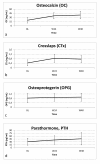Prospective evaluation of bone markers, parathormone and 1,25-(OH)₂ vitamin D in HIV-positive patients after the initiation of tenofovir/emtricitabine with atazanavir/ritonavir or efavirenz
- PMID: 22333484
- PMCID: PMC3296645
- DOI: 10.1186/1471-2334-12-38
Prospective evaluation of bone markers, parathormone and 1,25-(OH)₂ vitamin D in HIV-positive patients after the initiation of tenofovir/emtricitabine with atazanavir/ritonavir or efavirenz
Abstract
Background: Increased risk of fractures and osteoporosis have been associated with the use of antiretroviral drugs. There is a paucity of prospective evaluations of bone markers after the initiation of drugs currently recommended to treat HIV infection and results on the evolution of these markers are conflicting. Lastly, the effect of tenofovir on 1,25-(OH)₂ vitamin D is uncertain.
Methods: We performed a prospective study on the evolution of bone markers, parathormone and 1,25-(OH)₂ vitamin D before and after standard antiretroviral regimens. This was a sub-study of a trial conducted in antiretroviral-naïve patients randomized to tenofovir + emtricitabine in combination with either atazanavir/ritonavir (ATV/r) or efavirenz (EFV). Follow-up lasted 48 weeks. The following bone markers were analyzed: C-terminal cross-laps (CTx), osteocalcin (OC), osteoprotegerin (OPG), and receptor activator of nuclear factor κB ligand (RANKL). Mixed-factorial analysis of variance with random-coefficient general linear model was used to compare their trends over time and linear multivariable regression was performed with a backward selection method to assess predictors of their variations from baseline to week 48. Trends of parathormone and 1,25-(OH)₂ vitamin D were also evaluated.
Results: Seventy-five patients were studied: 33 received EFV and 42 ATV/r. Significant increases were found for all markers except for RANKL. There was a significant direct association between CTx and OC increases. Multivariable analysis showed that higher glomerular filtration rate (estimated through cystatin C clearance) predicted greater OPG increase, while older age, higher HIV RNA at baseline and use of ATV/r predicted greater CTx increase. A significant increase of parathormone accompanied the evolution of the study markers. 1,25-(OH)₂ vitamin D remained stable, though a seasonality variation was demonstrated.
Conclusions: These data demonstrate CTx increase (bone resorption marker) corresponding to OC increase (bone formation marker) early upon HAART initiation. Moreover, predictors of bone marker increases have been suggested, possibly indicating that a stricter monitoring of bone health and pro-active interventions are needed in older patients, those with higher HIV RNA, prescribed ATV/r rather than EFV, and with decreased renal function at baseline. Further studies are needed to clarify the mechanisms responsible for up-regulation of bone turnover markers, as well as to understand if and what markers are best correlated or predictive of pathological fractures.
Figures


References
-
- Young J, Bucher HC, Guenthard HF, Rickenbach M, Fux CA, Hirschel B, Cavassini M, Vernazza P, Bernasconi E, Battegay M. Virological and immunological responses to efavirenz or boosted lopinavir as first-line therapy for patients with HIV. Antivir Ther. 2009;14:771–779. doi: 10.3851/IMP1291. - DOI - PubMed
-
- Womack JA, Goulet JL, Gibert C, Brandt C, Chang CC, Gulanski B, Fraenkel L, Mattocks K, Rimland D, Rodriguez-Barradas MC, Tate J, Yin MT, Justice AC. Increased risk of fragility fractures among HIV infected compared to uninfected male veterans. PLoS One. 2011;6:e17217. doi: 10.1371/journal.pone.0017217. - DOI - PMC - PubMed
-
- Watts NB, Bilezikian JP, Camacho PM, Greenspan SL, Harris ST, Hodgson SF, Kleerekoper M, Luckey MM, McClung MR, Pollack RP, Petak SM. American Association of Clinical Endocrinologists Medical Guidelines for Clinical Practice for the diagnosis and treatment of postmenopausal osteoporosis. Endocr Pract. 2010;16(Suppl 3):1–37. - PMC - PubMed
Publication types
MeSH terms
Substances
LinkOut - more resources
Full Text Sources
Medical
Research Materials

